Legend 5-day Cruise
Galapagos Ecuador: (ZZ-EC-GALP07-4)
URL: https://www.hiddentrails.com/tour/outdoor_ecuador_Galapagos_legend_cruise4.aspx
Introduction
Galapagos
Ecuador
Galapagos Legend - 100 passengers
This magnificent vessel, with a capacity for 100 guests, has the charm of The Enchanted Islands; it is still small enough for a more intimate experience with friends and family. With her three different decks, the Galapagos Legend offers a great variety of comfortable and spacious social areas without losing its sense of intimacy. Its fantastic open decks allow you to admire the islands’ flora and fauna, enjoy a BBQ at night, or take some sun at the pool and bar areas.
Take advantage of its spacious inside auditorium for important conferences. Our philosophy is based on an environment without any formalisms or strict etiquette.
The facilities focus on both mind and body and provide you with those special places you need to exercise, rest or relax in a peaceful , harmonious setting.
The exceptional cuisine is comparable to that of the best restaurants in the world and merit special mention, ranging from the impressive breakfast buffet with freshly baked bread to the extraordinary menus drawn up by professional chefs for lunch and dinner. Visitors will enjoy local gastronomy, a wide variety of exotic fruits and the world’s best flavors, special menus for children, delicious vegetarian dishes or meals for those who have special diets. Once a week, there will be a barbecue at sea so you can sail, dine and enjoy islands landscapes.
Enjoy a charming casual marine décor, with accommodations in cabins with a view of the sea, delicious meals, 2 daily excursions to a habitat unlike any other, full of wildlife that have no fear of man. See prehistoric iguanas, giant tortoises, exotic birds and plants and beautiful landscape of volcanoes, lava cones and magma flows. Snorkel or dive along untouched beaches with a unique underwater world. Tours and lectures provided by licensed nature guides in various languages.
Relax
To relax in the sun or even bathe in the Jacuzzi, head to the Earth Deck, where the natural wonders of the Galapagos can be enjoyed from a whole different perspective, whether by the handrail of their decks, the comfort of a sun-lounger or from the balcony at the bow. There’s a space for everyone on these deceptively large yachts. Take a peak into our boutique for your shopping needs. On our new Sky Deck, view the dolphins playing in the water, swim in our pool, watch the wave from our panorama lounge inside with a drink from the Fisherman bar.
Enjoy
Enjoy the various activities on board. Enjoy our high-class gym. On board our ship, nights are magical, full of bright stars and countless constellations.
Learn
All of our highly-qualified multi-lingual naturalist guides are certified by the Galapagos National Park. On visits to the islands, they will accompany you every step of the way, taking time to explain the highlights as you wonder through this new and magical land. Every evening, these same guides will give you a lecture illustrated with multimedia presentation, imparting and sharing with you their knowledge of geology, history, evolution, flora and fauna of the islands. Also enjoy our library and for the little ones kid's corner where they can learn all about the Galapagos!
Feel Safe
Our customers’ safety and the conservation and respect for the environment are our main priorities. Our vessels comply with local and international standards enforced by ISM (International Management Code for the Safe Operation of Ships and for Pollution Prevention). Our crews are all highly trained in safety procedures and have years of experience at sea.
Accomodation
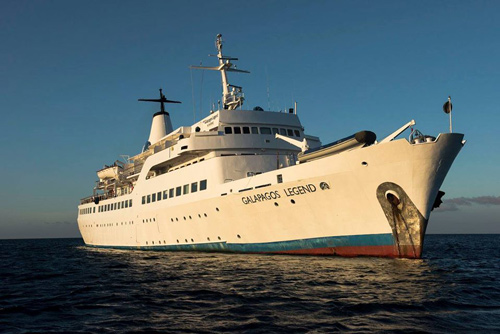
Accommodations
All nights of this trip are spent on the Legend. This impressive vessel, with capacity for 100 guests (56 cabins total), was refurbished in 2019. As well as being the fastest cruise ship operating in the Islands, it remains the only vessel with an onboard pool.
Beyond what you might expect, the Legend is equipped with a glass-bottom boat, transparent kayaks, a kid’s corner, a naturalist center, cinema, a boutique, snorkeling equipment room and a full auditorium facility.
There is also a wellness center (extra fee) that provides massages à la carte, yoga sessions and a gym.
There are 7 different cabin categories:
- Standard Cabin (3 cabins)
- Standard Plus Cabin (7 cabins)
- Junior Suite (24 cabins)
- Junior Suite Plus (4 cabins)
- Balcony Suite (10 cabins)
- Balcony Suite Plus (7 cabins)
- Legend Balcony Suite (1 cabin)
Each cabin includes a private bathroom (with hair dryer & toiletries), phone (local calls only), safe deposit box, air conditioning and a TV.
Voltage is set for 110 volts/60 Hz. There is Wi-Fi access in the lounge area.
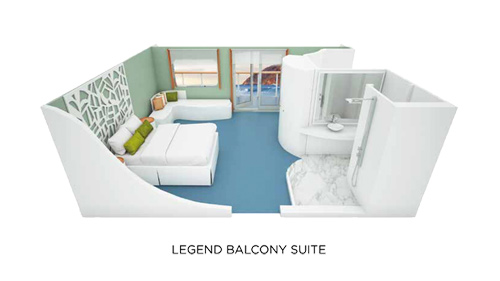
LEGEND BALCONY SUITE - measuring 33 m2 (355 ft2)
Double and triple occupancy possible.
This is our most comfortable cabin, including panoramic windows and a large balcony.
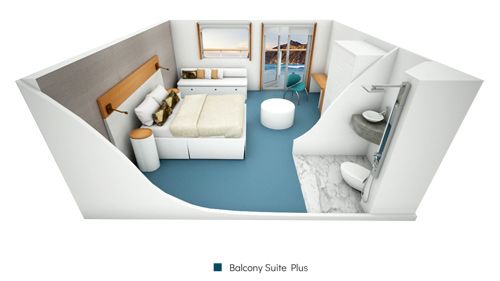
BALCONY SUITE PLUS - measuring an average of 22 m2 (237 ft2)
Double & triple occupancy possible.
They include panoramic windows and a balcony.
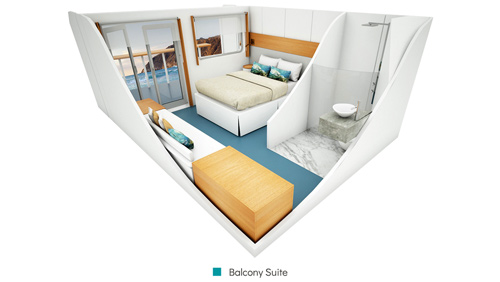
BALCONY SUITE - measuring an average of 22 m2 (237 ft2)
Double & triple occupancy possible.
They include panoramic windows and a balcony.
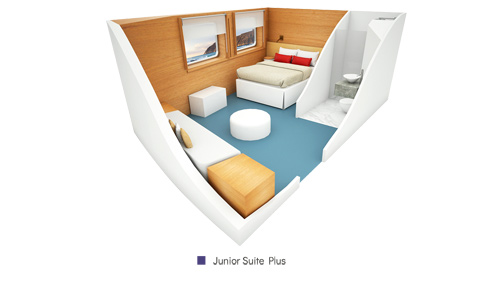
JUNIOR SUITE PLUS - measuring an average of 20 m2 (215 ft2)
Double, triple & quadruple occupancy possible. Interconnected cabins available.
There are 2 panoramic windows per cabin.
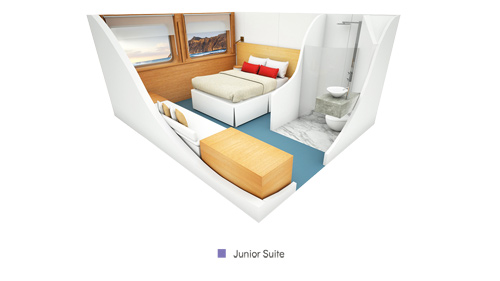
JUNIOR SUITE - measuring an average of 15 m2 (161 ft2)
Double & triple occupancy possible. Interconnected cabins available.
There are 2 panoramic windows per cabin.
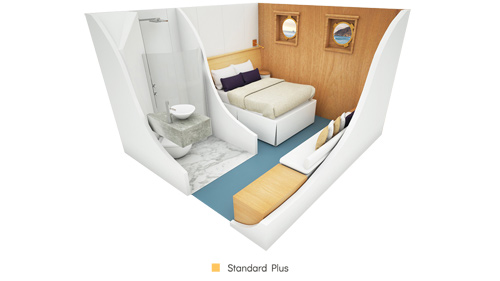
STANDARD PLUS - measuring an average of 11 m2 (118 ft2)
Double & single occupancy possible.
There are 2 portholes per cabin.
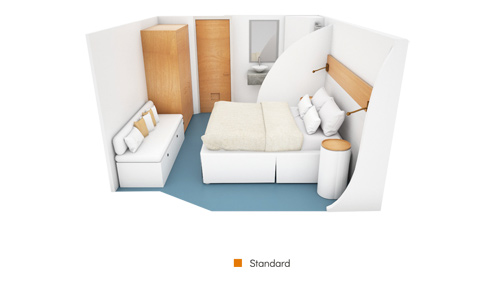
STANDARD INTERIOR - measuring an average of 13 m2 (140 ft2)
Double & single occupancy possible.
These cabins are located in the interior, so there are no ocean view.
Additional onboard services and facilities include:
• Drying machines available for complimentary use
• Variety of onboard activities
• Briefings on the following day’s activities
• Informative lectures about the Galapagos
• Medical attention 24 hours a day
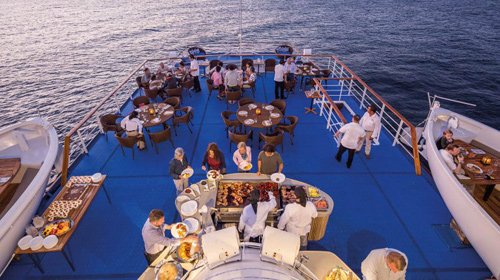
Meals
All meals are included during the cruise.
Lonesome George Restaurant
This acclaimed restaurant will surprise you with its wide range of mouth-watering, culinary delights. Using fresh ingredients, we serve a high level of international and local cuisine from our professional chefs. With an à la carte dinner, we offer a vegetarian and children’s menu. We also provide a kosher-friendly option with tableware and a private restaurant available upon request.
Al Fresco Restaurant
BBQ dinner amid the islands in a buffet-style meal with a great selection of cuts, sea food, vegetables, and salad options. Two lifeboats with tables can accommodate up to 14 people each for a unique dining experience. Reliant on the weather, this meal in the open space might be subject to change either for breakfast or lunch.
Make the most of your cruise experience with our beverage packages (not included in tour price - to be paid extra) that offer a range of soft drinks, local beer, a selection of sparkling wines and classic cocktails to be served at our bars and restaurants.
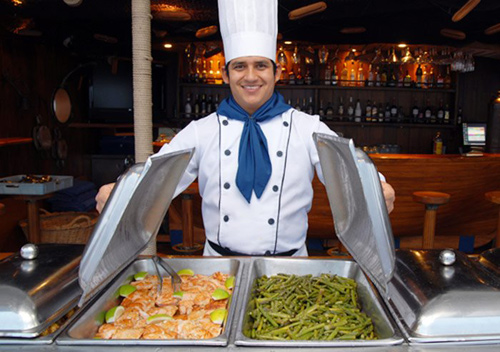
Riding
Staff
Every crew member is trained to provide a first-class service with exceptional professionalism. Genuinely friendly individuals, fully dedicated to providing the best hospitality services, with attention to detail
and personalized assistance, our crew’s passion and commitment create a one-of-a-kind experience for our guests.
Physical requirement for the cruise
We recommend that passengers be in reasonably good physical condition as some trails are difficult therefore elderly or disabled people may find them too hard. The passengers with difficulties must notify us about their physical condition in order to make the necessary arrangements.
We reserve the right to refuse a passenger if someone failed to inform of any physical disability, or who in the opinion of the company, constitutes a danger to themselves, other guest, members of the crew, or the smooth operation of the vessel.
Dry Landings and Wet Landings
On a dry landing, passengers step directly from a dinghy to rocks or onto a dock. We recommend: walking shoes, sunscreen, hat, water, insect repellent and a light jacket.
Wet Landing means that the dinghy edges up onto a beach, where you step into knee-deep water assisted by crew members and guides. We recommend: swimming suit or shorts, walking shoes or slippers, towel that will be provided by the crew while disembarking, sunscreen, hat, insect repellent, plastic bag, well insulated cameras and a windbreaker.
Smoking policy on board the ship
It is forbidden to smoke inside the yachts or the vessel.
Smoking is allowed ONLY on the sun decks.
How can I pay my expenses on board?
Upon arrival, a bill will be opened for you. If you wish to pay with your credit card, we ask you to come to reception to sign a voucher and to make copies of your passport and credit card. Authorizations take about 48 hours, so please do this on your first cruise day. We accept all main credit cards: Diners, Visa, Mastercard , American Express. Travellers Checks, Euros and US Dollars are also accepted.
What would happen if I get seasick?
We hardly get a seasick passenger on board. However, we have seasick medication on board all our ships, but if you are particularly sensitive you can bring your own medication.
Is the water safe to drink?
The tap water is generally not safe to drink in Ecuador. Bottled water is readily available at tourist sites, hotels, and restaurants. On board our yachts you will find bottled water in your room. Ice used onboard the yachts is generally made with purified water as well.
Itinerary
Sample Itinerary: West option - subject to changes
Day 1 (Thursday): Arrival & Mosquera Islet Visit
Departure from Quito or Guayaquil to Baltra (2 ½ hours flight). Passengers are picked up at the airport by our naturalist guides and taken on a ten minute bus drive to the pier to board the Galapagos Legend.
This afternoon, wet landing on Mosquera Islet, located between North Seymour and Baltra Island. This flat, sandy island has a large colony of sea lions. It is also an excellent site to observe shorebirds such as herons and lava gulls. There is no trail on the islet, the visitor can enjoy the open area. Most of the islet is covered with sand and barren lava rock. Very little sesuvium portulacastrum plants grow on the sand.
Activity Difficulty: easy (sandy terrain)
Activity Duration: 1 ½-hour walk & snorkeling
Day 2 (Friday): Santiago & Rabida Islands
We start the day with a wet landing at Egas Port (Santiago Island), a black volcanic sand beach, visited by Darwin in 1835. The first section of the trail is formed of volcanic ash (eroded tuff) and the other half is an uneven terrain of volcanic basaltic rock. The unique, truly striking layered terrain of Santiago shore is home to a variety of animals including the bizarre yellow-crowned night heron and marine wildlife including lobster, starfish and marine iguanas grazing on algae beds alongside Sally light-foot crabs. It is easy to see colonies of endemic fur seals swimming in cool water volcanic rock pools.
Activity Difficulty: intermediate (flat & semi-rocky terrain)
Activity Duration: 1 1/2-hour walk / 1-hour snorkeling
After lunch, wet landing on Rabida Island. Dark-red sand covers these unique beaches with incredible landscape. Rabida is considered the epicenter of the Galapagos Islands due to the diversity of its volcanic geology. Nesting Brown Pelicans are found from July through September and nine species of the famous Darwin’s finches can be seen. We will also take a dinghy ride along cliffs to observe nesting seabirds, and snorkel off the coast, where marine life is particularly active.
Activity Difficulty: easy (sandy terrain)
Activity Duration: 1h30 walk / 1 hour snorkeling / 1 hour dinghy ride
Day 3 (Saturday): Isabela Island
In the morning, wet landing (might be difficult due to the tide) at Urbina Bay. Volcanic black beach, depending on the season, it is possible to find giant tortoises, land iguanas, and the unusual flightless cormorant. After a short walk inland it´s snorkeling time, a chance to swim with sea turtles, sea lions, and countless tropical fish. Urbina Bay features a wide variety of plants with the different range of colors in flowers, attracting different insects, birds, and reptiles. One of the highlights of the island is the uplifted coral reef that resulted from the 1954 seismic activity; here the views of Alcedo Volcano are remarkable. When navigating from Urbina to Tagus Cove whale watching is usual in May – December.
Activity Difficulty: intermediate (flat terrain)
Activity Duration: 1h30 walk / 1 hour snorkeling
This afternoon, dry landing on Galapagos’ largest island (Isabela) where we will learn about the eruption of the 5 volcanoes that form it. The trail leads from Tagus Cove to Darwin’s salt-water crater Lake and excellent views of lava fields and volcanic formations. We will return by the same path for a dinghy ride along a shoreline full of marine wildlife, where we will admire a variety of seabirds*, such as Blue-footed Booby, Brown Noddy, terns, Flightless Cormorant and depending on the season, a large number of Galapagos Penguins* which are only 35 cm. tall; the only penguin species in the world to extend its range into the northern hemisphere along the equator. They are monogamous and lay their eggs in small cracks of lava, on the lower parts of the island near the shoreline not reached by the ocean waves. The population of penguins on the islands is about 2,000 individuals, most of which live on this western portion of Isabela; others are scattered further south on the island. We will have an opportunity to snorkel in deep water. Graffiti believed to have been left by19th-century pirates is a curious reminder of an intriguing past.
Activity Difficulty: intermediate / difficult (steep)
Activity Duration: 2 hour walk / 40 minutes dinghy ride / deep water snorkeling 1 hour
Day 4 (Sunday): Fernandina & Isabela Island
After breakfast, we visit the youngest island of the Galapagos and one of the most pristine in the world: Fernandina island. Fernandina is simply the 'marine iguana capital of the world'. This desolate volcanic backdrop is
home to a huge concentration of these enigmatic reptiles. Incongruously, sharing the same shoreline, we can find the diminutive Galapagos penguins. Here we also have the exciting opportunity to snorkel with marine iguanas feeding underwater, penguins, turtles and the bizarre, endemic, flightless cormorants.
Difficulty level: intermediate (flat/semi rocky terrain)
Duration: 1 ½-hour walk / 1-hour snorkeling
Later that day, we visit Punta Vicente Roca, on Isabela island. This is a spectacular visitor site, surrounded by immense cliffs of the eroded volcano. Studded with resting sea birds such as brown noddies and Nazca boobies, we will enjoy them in close proximity from our dinghies. Snorkeling here is superb, with certain species of fish only found in the west of the archipelago. We also have a very real chance of swimming with penguins and potentially a plethora of green turtles.
Difficulty Level: moderate / high
Duration: 1-hour snorkeling / 1-hour dinghy ride
Day 5 (Monday): Departure
For our last morning expedition, dry landing on Santa Cruz Island. In the mountains of Galapagos, it is possible to admire different kind of birds, such as: tree and ground finches, vermillion flycatchers, paint-billed crakes, yellow warblers, and cattle egrets (usually standing on the tortoises’ shell). The journey to the reserve offers great opportunities to see the contrasts that the island offers in reference to the variety of ecosystems. The road goes from the coast through the agricultural zone and straight up to the dense humid forests. Often, Galapagos Giant Tortoises are also seen on the way, wandering through pastures in the paddocks. This spot is a birdwatchers’ haven, since almost every land bird present on the island lives or migrates here.
Activity Difficulty: easy (flat & muddy terrain depending on season)
Activity Duration: 45-minutes drive / 1 ½-hour walk
After the visit, passengers will be transferred to the airport for their return flight to Guayaquil or Quito.
Sample Itinerary: South option - subject to changes
Day 1 (Thursday): Arrival & San Cristobal Island Visit
Departure from Quito or Guayaquil to San Cristobal in a 2-hour flight. Upon arrival, passengers are picked up at the airport by our naturalist guides and taken on a ten-minute bus drive to the pier to board the Galapagos Legend.
This afternoon, dry landing in Puerto Baquerizo Moreno, the capital of the Galapagos Islands. Passengers visit the Interpretation Center, an excellent place to learn about islands’ history in The Museum of Natural History which displays information about the volcanic origins of the islands, their remoteness from the continent, ocean currents, climate, the arrival of the different species and their colonization, among other points of interest. The human history is also showcased, chronologically narrating the most significant events related to the discovery and the island’s colonization.
Activity Difficulty: easy /intermediate (flat/stairs)
Activity Duration: 1-hour visit / 1-hour walk
Later that day, visit of Tijeretas Hill, with a high-intensity walk amidst beautiful landscapes and a magnificent view at the foot of a frigate bird nesting colony.
Activity Difficulty: difficult (rocky terrain)
Activity Duration: 1-hour visit
Day 2 (Friday): Española Island
We start our day with a wet landing on a beautiful white coral sandy beach guarded by a colony of sea lions: Gardner Bay. There are no trails, so we stay along the shore where we can spot Galapagos hawks, American Oystercatchers, Galapagos Ground Doves, Hood mockingbirds, Yellow Warblers, lava lizards, marine iguanas, and three species of Darwin’s finches: a subspecies of the Large Cactus Finch, which is similar to the large ground finch, the Small Ground Finch (Geospiza fuliginosa) and the Warbler Finch (Certhidea Olivacea), another endemic subspecies. Swimming and snorkeling offer a great variety of the Galapagos’ marine wildlife: king angelfish, Creole fish, damsel fish, parrotfish, manta rays, and white-tipped reef sharks.
Activity Difficulty: easy (sandy terrain)
Activity Duration: 1-hour walk / 1-hour snorkeling
In the afternoon, dry landing at Suarez Point. Here, we can see that Espanola is an island of geological interest. We explore volcanic formations and a riveting wildlife: large sea lion colonies and seabirds including the Española mockingbird, Nazca Boobies, and the spectacular Red-billed Tropicbird. You will also encounter marine iguanas, lava lizards, and the colorful Sally Lightfoot Crabs.
A somewhat lengthy hike will bring you among Nazca and Blue-footed Boobies, right up to nesting grounds that sometimes overlap the trail. Other birding favorites include Galapagos Dove, Galapagos Hawk, Swallow-tailed Gulls and the world’s largest colony of Waved Albatross, an unequivocal highlight during mating season (May-December).
Admire the island’s dramatic backdrop, featuring the famous “Soplador”, a seaward blowhole that shoots up water up to 23 m (75 ft) in the air.
Activity Difficulty: difficult (rocky terrain)
Activity Duration: 2½-hour walk
Day 3 (Saturday): Floreana Island
After breakfast, wet landing at Post Office. Located on the north side of Floreana, the bay was named like this because in 1793 Captain James Colnett installed a wooden barrel which served as an informal post office for sailors passing through, who would take letters with them back to their destinations. Today, visitors continue the tradition by placing unstamped postcards inside the barrel, hoping that some other traveler, going to the letter destination, will take it back for free. The chances are that the letter posted can take a long time to arrive at its destination. However, there have been cases where it has arrived before the sender.
We may also encounter Darwin’s finches, Yellow Warbler and Lava Lizards. Great snorkeling opportunities with Green Pacific Sea Turtles. As well, the island is best known for its endemic vegetation: Scalesia villosa, Lecocarpus Pinnatifidus, and the Galapagos Milkwort. Snorkelers can practice on the main beach among playful sea lions.
Activity Difficulty: easy (sandy terrain)
Activity Duration: 30-minutes walk / 1-hour snorkeling
Later that day, wet landing, on an olivine green, sanded beach: Cormorant Point. We hike from the black mangrove beds to a brackish lagoon, which usually holds one of the largest flamingo populations in the Galapagos. This island features some endemic plants such as Scalesia villosa, white and black mangrove, and holy stick. The trail continues to a beautiful white sandy beach, one of the most important nesting sites of Green Pacific Sea Turtles. It is important to avoid walking in the water due to the Sting Rays that may be hiding in the sand, which can be dangerous if accidentally stepped on. From the beach, one can spot sea turtles, blue-footed boobies plunging into the water, and small reef sharks floating along the shoreline in the search for food.
This coral-sand beach marks the end of our trail, and we head back to the olivine beach we landed on, to swim or snorkel amongst sea turtles, reef fish, sea lions and, on a good day, white-tipped reef sharks. A small colony of penguins resides on Floreana and can sometimes be observed as well.
Activity Difficulty: easy (sandy & flat terrain)
Activity Duration: 1-hour walk / 1-hour snorkeling
Day 4 (Sunday): Santa Cruz Island
Arriving to a small lava dock, our first encounters are with marine iguanas that blend in perfectly to the dark rock. As we walk past large prickly pear cacti, we arrive to one end of a long, sickle-shaped Beach, with Dragon Hill standing in the distance. Our walk takes us on a circular path, past a shallow lake where flamingos frequently come to feed. Waders such as stitlts, turnstones and sandpipers work the muddy edges frenetically looking for food as we continue inland to a dry forested habitat where land iguanas nest and burrow.
Activity Difficulty: intermediate (rockyterrain)
Activity Duration: 2-hour walk
This afternoon, we feel the indescribable feeling of being where no one else has. relax on a powdery Beach, snorkel around turquoise water islets and hike beside salt pools and dried white corals. Be one of the first humans to visit Punta Bowditch!
Activity Difficulty: easy (sandy terrain)
Activity Duration: 30-min walk / 1-hour snorkeling
Day 5 (Monday): Departure
For our last morning expedition, dry landing on Santa Cruz island. Here, it is possible to observe different kind of birds such as: tree and ground finches, vermillion flycatchers, paint-billed crakes, yellow warblers and cattle egrets (usually standing on tortoises' shell). the journey to the Highland Tortoise Reserve offers great opportunities to see the contrasts that the island offers in reference to the variety of ecosystems. the road goes from the coast through the agricultural zone and straight up to the dense humid forests. Often, Galapagos giant tortoises are also seen on the way, wandering through pastures in the paddocks. This spot is a birdwatchers' haven, since almost every land bird present on the island lives or migrate here.
Activity Difficulty: easy (could be muddy depending on the season)
Activity Duration: 45-min drive / 1.5-hour walk
After the visit, passengers will be transferred to the airport for their return flight to Guayaquil or Quito.
Rates and Dates for Legend 5-day Cruise
Rates include:
Accommodation, All meals, Welcome & farewell cocktails, Coffee / tea station, 2 daily excursions, Multilingual naturalist guides (English/Spanish), Snorkeling opportunities, Optional Diving, Fuel surcharge, Free Shuttle service from Quito/Guayaquil Airport-roundtrip (when domestic flight is purchased in combination with cruises)
Guides speaking French, German and Italian upon request
Rates Note:
The transit card fee and the Galapagos entrance fee must be paid to the CGG (Consejo de Gobierno de Galapagos) at the airport in cash.
* prices are per person based on double/twin occupancy
Rates Note:
The transit card fee and the Galapagos entrance fee must be paid to the CGG (Consejo de Gobierno de Galapagos) at the airport in cash.
Transfer and Other Charges:
|
2022
|
Air ticket from Quito/ Guayaquil to Galapagos, per adult, roundtrip
|
$495
|
|
2022
|
Transfer from Quito/ Guayquil Airport (if airfare not booked) - please inquire (Mandatory)
|
$0
|
|
2022
|
Single Supplement: +50% on standard (+75% on holiday season)
|
$0
|
|
2022
|
Child discount (under 12) - please inquire
|
$0
|
|
2022
|
Triple room discount - please inquire
|
$0
|
|
2022
|
CGG Migration Card (mandatory), pp
- to be paid locally
|
$20
|
|
2022
|
Entrance fee to Galapagos (mandatory), per adult
- to be paid locally
|
$100
|
|
2022
|
Entrance fee to Galapagos (mandatory), per child under 12
- to be paid locally
|
$50
|
|
2022
|
Supplement to guarantee Balcony Plus & Junior Suite Plus rooms, pp
|
$250
|
Dates Note:
Weekly departures on Thursday to Monday
Rates do not include:
Drinks, Air ticket from Quito/ Guayaquil to Galapagos (can be booked for extra fee), Galapagos Entrance Fee (mandatory), CGG Migration Control Card (mandatory), Gratuities, Travel insurance, Gratuities, Snorkelling / diving equipment & Wet suits / kayak rentals
Other Info
Meeting: Baltra
Airport: Baltra
Transfer: Baltra
Climate:
Galapagos area
|
Month
|
Jan
|
Feb
|
Mar
|
Apr
|
May
|
Jun
|
Jul
|
Aug
|
Sep
|
Oct
|
Nov
|
Dec
|
|
Average High Temperature (°F)
|
86
|
86
|
88
|
88
|
79
|
79
|
79
|
79
|
79
|
81
|
82
|
84
|
|
Average Low Temperature (°F)
|
72
|
75
|
75
|
75
|
72
|
70
|
66
|
66
|
66
|
68
|
70
|
72
|
|
Average High Temperature (°C)
|
30
|
30
|
31
|
31
|
26
|
26
|
26
|
26
|
26
|
27
|
28
|
29
|
|
Average Low Temperature (°C)
|
22
|
24
|
24
|
24
|
22
|
21
|
19
|
19
|
19
|
20
|
21
|
22
|
Source: www.galapagosislands.com
Seasons
You will be in a sunny year round destination; the warmest months are from December to April. January to March can be hot and humid, but also mostly green at this time. The months from July to November are cooler. The average year-round temperature is 24°C. (76°F).
Galapagos Dry Season (June to December)
From June to December the southern trade winds bring the colder Humboldt Current north to the Galapagos. This means that the water is cooler, and a layer of high atmosphere mist pervades the island skies. In effect, the highlands of the larger islands are kept green and lush while the sea level islands and shorelines have little precipitation. Thus, June to December is generally called the "dry season" which is known for its blue skies and mid-day showers.
During this season the tourists may observe a large number of species around the islands and in the sea such as giant tortoises, humpback whales, blue-footed boobies, cormorants, oyster catchers, lava lizards, Galapagos hawks, masked boobies, swallow-tailed gulls, sea lions, lava herons, brown noddies, and penguins. Due to the water temperature, it is the perfect time for diving.
Galapagos Wet Season (December to May)
This period is considered the "wet (warm) season." During this warmer season, the Galapagos' climate is more tropical with daily rain and cloudier skies. Also, the ocean temperature is warmer for swimming and snorkeling
During this season the tourists may observe a large number of species around the islands such as marine iguanas, sea turtle, land iguanas, flamingos, white-cheeked pintails, masked boobies, marine iguanas, albatross, and blue-footed boobies. Since the water's warmer, snorkeling is highly recommended during these months.
Special note - Galapagos Weather for Divers
The Humboldt Current's influence brings cold waters especially during the misty, rainy season (cool weather) from July to December. "El Niño" current may bring warm waters to the Galapagos and will make the surface warmer and rainfall increase (January to June).
The water temperature varies during the year:
January to June: from 70°F (21°C) to 80°F (27°C)
July to December: from 65°F (18°C) to 75°F (23°C)
What To Bring:
We advise you to bring comfortable breathable clothes; shorts, T-shirts, swimsuits and good hiking shoes are required to walk over the lava rock paths, personal medication, a good camera and plenty of memory sticks or film, sun block, sunglasses, binoculars. It is also a good idea to bring water shoes or sport shoes that can be wet, for the wet landings.
Galapagos means nature, moving, enjoying and relaxation, therefore you don’t have to worry about dressing up. Casual and light clothing is recommended on board the ship.
For dinning: you will need a semiformal wear and a sweater or jacket for windy nights.
For shore excursions comfortable clothing is a must, preferably shorts, bathing suits, head covering, walking shoes, tennis shoes, windbreaker type jacket, binoculars, camera and plenty of film. Sun rays are very strong in the Galapagos Islands. Do not forget to take with you enough high grade sun block. Also, put your cameras in self-sealing plastic bags to protect them from the water, especially during landfalls.
Internet is not available yet, but you can always get internet in Puerto Ayora and San Cristóbal.
|
|